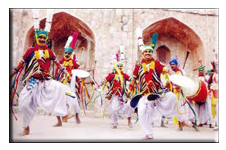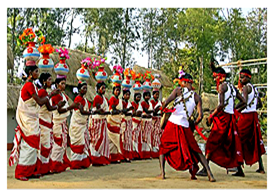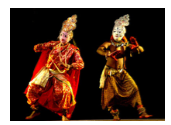In Jharkhand, each form of dance reflects the ethos and culture of a place. They express the feelings and emotions of the common man. Most of the dances are performed by men in the garb of women. The dances of Jharkhand are
Chhou dance

This is a famous tribal dance performed mainly during the night in any open space, field or ground. Since the characters in the dance depict various Gods the dancers maintain the sacredness and sanctity by taking a bath and doing pooja before a performance. Surrounding the dance area fire poles called Mashaal are fixed around the dance area for lighting purposes though they have now been replaced by electric lights in urban areas. Huge colourful masks called Chhou masks made of paper mache are worn by the dancers and the dance is generally in the form of a Nritya Natika or dance drama. Mythological stories from the Ramayana and Mahabharata are enacted accompanied by traditional instruments like Nagara drums, flute etc.
Paika

It is generally performed by the Munda community. In this dance martial arts is combined with dance steps. It depicts the various steps in the preparation of a war. To protect themselves the dancers wear headgear and safety chest plates with bells on their anklets. They wear colourful robes and carry a sword in one hand and a shield in the other. This is accompanied by musical instruments like the Nagara drums, Dhak, Shehnai, Narsingha and Bheir. This dance is generally performed to welcome guests during important functions.
Hunta

This dance is performed on festival and special occasions by the Santhal tribes showcasing their strength of unity and pride. The dancers wear colourful costumes of dhoti and turban and decorate their body with various species of flora. They design their clothes and use branches, leaves and flowers along with their clothes as the Santhals are said to be close to nature. The dance depicts in mime form, the hunt with bows and arrows, stalking and killing the animal.
(Karma) Karam

This dance is derived from a sacred tree named Kadamba which is believed to bring prosperity and good luck to the people and depicts the celebration of the planting of the tree. It is performed during the Kadamb (Karam) festival in the month of August. This is one of the few dances in which women too are allowed to participate. The dancers form a circle and dance with their hands on each other’s waists while passing on a branch of the tree to each other. After one complete circle of passing the Karma branch, it is washed with rice and milk. The branch is not allowed to touch the earth after these rituals and it is once again raised between the dancers.
Barao
This dance is performed by the Oraon community generally in the month of Baisakh (April – May) in an Akhada or performing area. Prayers are offered to Mother Earth for a good monsoon so that a rich harvest may be secured.
Jhenana Jhumur
This dance is performed by the women of the Nagpuri and Santhal communities during all festivities and occasions especially during the harvest season.
Mardani Jhumur
It is a semi martial art form performed by the men of the Nagpuri and Southern tribes. The musical instruments used for this dance are Dhol, Nagara, Shenai, Kartal and Jhanj. Some female dancers known as Nachnis also join this dance along with the men.
Jhitka and Danga
This dance is performed by men and women and the headgear and costume worn are similar to those of the Paika dance. This dance expresses happiness and joy and celebrates different feudal traditions.
Lahasuya
This dance is generally performed by men and women as a call to rain specially when there is a drought. It is accompanied by the madol or tumdak the double sided barrel drum.
Domkach

This is a traditional dance performed by the women in the bridegroom’s house when the ‘baraat’ party has gone to the bride’s house. Through satiric songs they crack jokes while moving in circles.
Ghora naach
This dance is performed by men during wedding ceremonies wearing loose horse puppets around their waists and they dance to the rhythmic beats of the folk instruments
